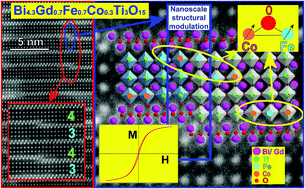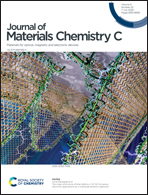Cobalt-induced structural modulation in multiferroic Aurivillius-phase oxides†
Abstract
Attaining robust magnetic long-range order in ferroelectric Aurivillius-phase oxides at room temperature has recently attracted considerable attention of materials scientists and engineers for the development of magnetoelectric-active materials in microelectronics and spintronics. Here, we report the structural evolution and its relation to the macroscopic magnetization of a series of samples of Aurivillius (Bi4.3Gd0.7)(Fe1−xCox)1+yTi3−2yNbyO15 (x = 0, 0.3, 0.5 and y = 0, 0.3) compounds prepared by a solid state reaction, aiming at shedding light on the Co substitution-induced ferromagnetism at room temperature and above. The Co-free composition showed a single-phase four-layered Aurivillius structure (space group A21am), while the Co substitution was found to give rise to a mixed-layer structure composed of four- and three-layered phases. Rietveld analysis of the synchrotron X-ray diffraction data showed that the reduction in the number of layers across the Aurivillius morphotropic transition boundary is accompanied by a structural phase transformation from A21am to B2cb. The disordered intergrowth of these phases was evidenced by high-resolution transmission electron microscopy and found to originate from a nanoscale structural modulation occurring at the interface between the two phases. A sextet suggesting long-range magnetic ordering in the doped samples was deduced from Mössbauer spectra. Magnetic-property measurements, indeed, confirmed a ferromagnetic state of these samples at elevated temperatures. The highest values of the remanent and saturation magnetization at room temperature were obtained for the compositions with x = 0.3, in which the occurrence and enhancement of the magnetization can be attributed to the ferromagnetic clustering of the FeO6 and CoO6 octahedra and, partly, also to spin canting effects and/or a double-exchange magnetic interaction between the mixed valence cobalt through oxygen. The cooperative freezing of randomly distributed Fe–O–Co clusters is suggested to be responsible for the spin glass-like behaviour observed at low temperatures. The occurrence and enhancement of the magnetization in the ferroelectric Co-doped Aurivillius ceramics are attributed, respectively, to the structural modulation and the population of the ferromagnetic clusters near the interface of the four- and three-layered phases.



 Please wait while we load your content...
Please wait while we load your content...